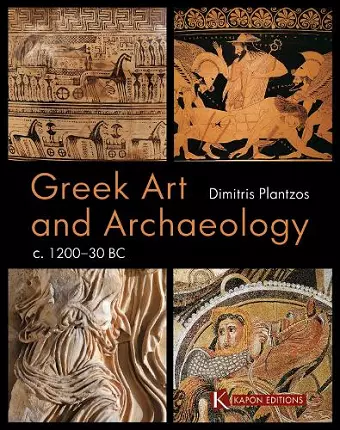Greek Art and Archaeology c. 1200-30 BC
Format:Paperback
Publisher:Kapon Editions
Published:1st Apr '16
Currently unavailable, and unfortunately no date known when it will be back

This luxuriously illustrated book surveys Greek archaeology from the collapse of the Mycenaean palaces to the subordination of the last Hellenistic kingdoms to Rome. Its aim is to study Greek art through the material record, and against its cultural and social backdrop. It takes the reader on a tour of ancient Greece along the most important period in its history, the 1st millennium BC.
Architecture, city planning, sculpture, painting, pottery, metallurgy, jewellery, and numismatics are some of the areas covered. With concise, systematic coverage of the main categories of classical monuments, the book caters for the non-specialist looking for the essential in ancient Greece, students of Greek archaeology and art, as well as anyone interested in Greek art and culture. The text is divided into accessible, user-friendly sections including case studies, terminology, charts, maps, a timeline and full index.
This is the first English language edition of the original Greek edition and was thoroughly revised and expanded by Dimitris Plantzos before translation by the British archaeologist Nicola Wardle.
592 colour illustrations.
‘This is one of the most instructively illustrated textbooks that this reviewer has ever seen. Each of the 592 magnificent colour illustrations has been strategically positioned to coordinate with accompanying test and incredibly well blended into the large page format. Commentary is well organized, terse, pointed and minimalist in description. [...] As a textbook this volume provides a very viable platform current, comprehensive, and convenient for teaching a survey approach which promotes more than a fleeting academic traction.’
Henry V. Bender, St. Joseph's University, Classical Journal, 2017.09.01
‘This elegant edition – yet another excellent publication by Kapon – completes the task with integrity by offering an attractive introduction to the study of ancient Greek art. As promised in the Introduction, the book achieves a fortunate combination of a thorough study of objects and a systematic effort to render them understandable, not only as ‘art’ but as sources of historical and cultural information as well. The student of classical antiquity will find here useful terminology, tips in methodology, and suggestions for further reading.
‘The book, with its elegant editing and the harmonious development of its subject matter, is an enjoyable read and a particularly useful guide not only for classical archaeological students and scholars but for every reader interested in Greek antiquity’
Themata Archaiologias 2017 1.1
‘Plantzos’ text offers a good balance between monuments and narrative; that is, the number of monuments is manageable and the discussions include, to a certain degree, stylistic and cultural information.
Linda Maria Gigante, University of Louisville, Bryn Mawr Classical Review 2017.04.35
‘Plantzos' book differs from the many available handbooks on Greek art (including my own, now rather old) in a number of significant ways. It is a big book but very succinct, and thereby packs a lot of information not accessible in the usual handbooks, and it presents the whole in a proper historical perspective including the element of 'reception'. It is moreover heavily illustrated, which is essential but often inadequate through lack of energy on the part of the authors or publishers; it is not easy nowadays to assemble the impressive range of illustrations that appears here. Moreover, it includes much that wrongly gets ignored in other books - plans, reconstructions, etc. Another advantage is that it is written by a Greek scholar and teacher so that there seems to be a certain immediacy of communication of what is essential in Greek art.’
Sir John Boardman, Emeritus Professor of Classical Archaeology, Oxford University
This readable and thorough introductory textbook includes boxes with information on people, places, and artefacts, and definitions of terms to enhance the text. The line drawings and many beautiful illustrations capture the reader's interest. Chapters cover the methods of classical archaeology, the early Iron Age, and the Archaic, Classical, and Hellenistic periods. [...] Of interest to professors seeking a new textbook, and students and others interested in an introduction to classical art, culture, and archaeology. Summing Up: Recommended. General and undergraduate collections; faculty.
Nancy J. Mactague, Aurora University, CHOICE, March 2017
‘This beautifully illustrated volume situates Greek art within the framework of classical archaeology (and also classical studies), as well as within the growing field of reception studies. He interests readers in the history of the discipline, including the place of museums in historical discourse, and the importance of archaeological context. His emphasis on terminology, the combination of a linear and thematic approach, rich contextual references, and bibliographies help to move this old conversation into a new direction. The book is systematic and comprehensive on the one hand, yet user-friendly on the other (e.g. box texts, bullet points, generous illustrations). Not surprisingly, Plantzos offers ample discussions of gems, coins, terracottas, bronzes, and wall-paintings (something not attempted in quite this way since Boardman), indicating that these categories are as important as sculpture and architecture in the study of ancient Greek visual and material culture.’
Tyler Jo Smith, Associate Professor of Mediterranean Art and Archaeology, University of Virginia
ISBN: 9786185209001
Dimensions: 280mm x 220mm x 20mm
Weight: 1340g
304 pages